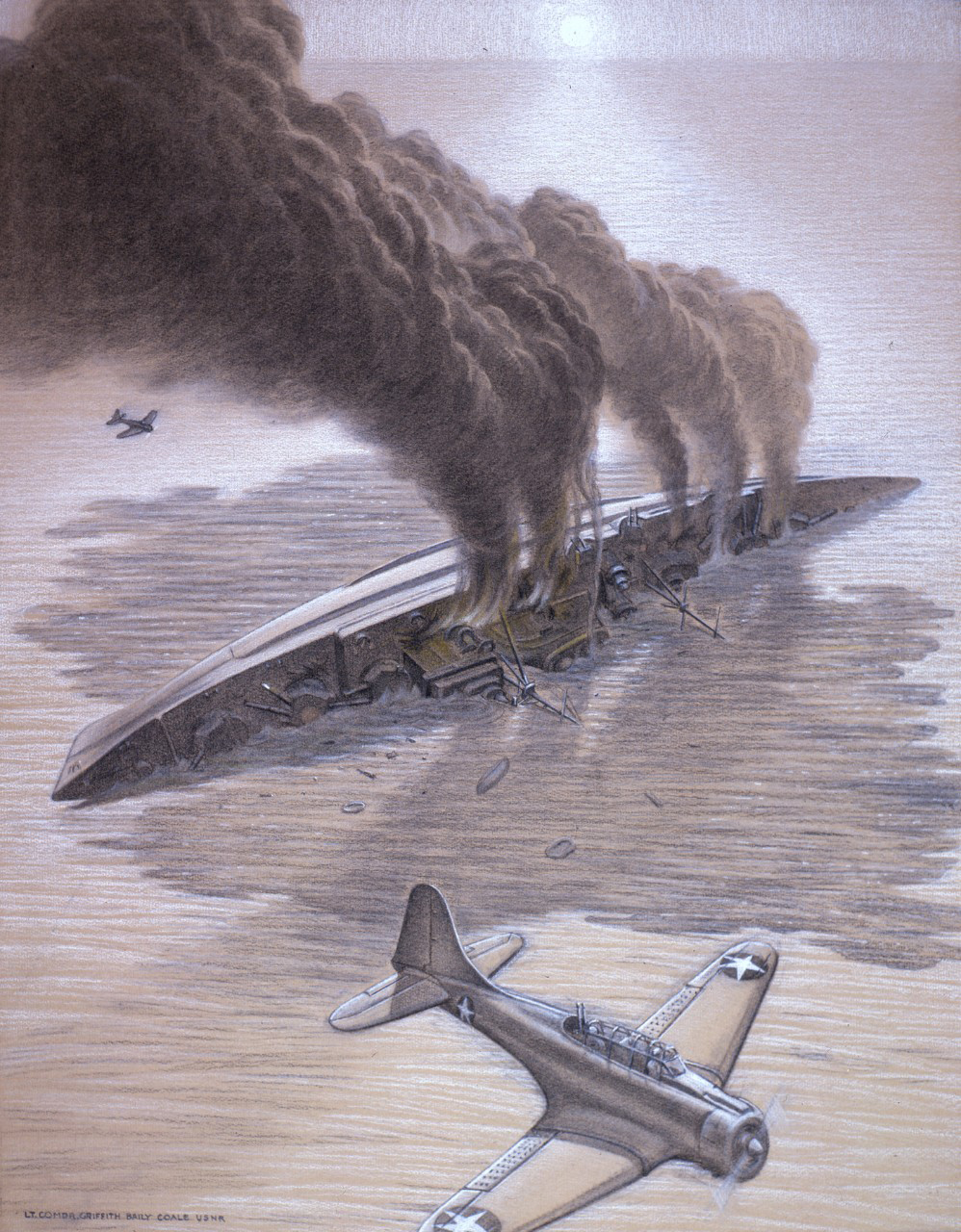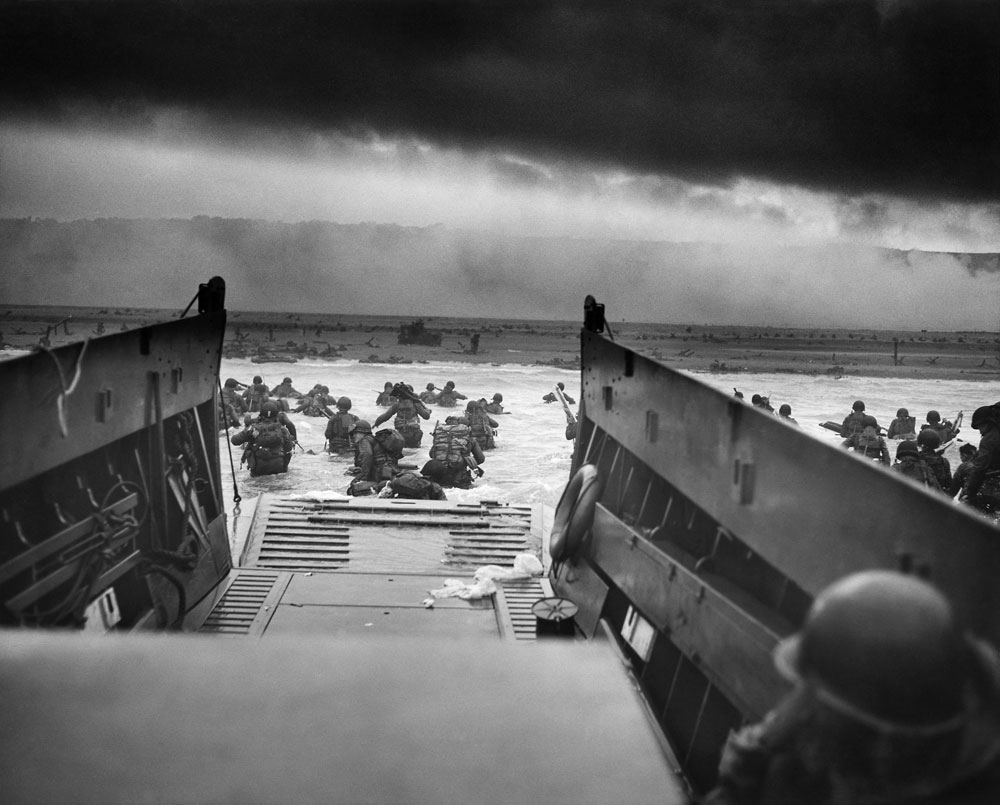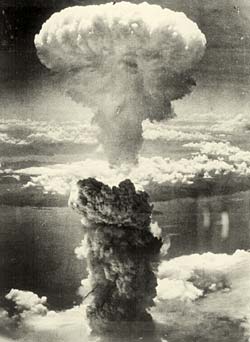This chapter outlines major events on the battlefronts of the war. Many
events were described in Oregon newspapers or radio broadcasts and were part of the daily thoughts and conversations of Americans, nearly all of whom had a son, father, brother, or neighbor fighting in a far off place. News of battles motivated Oregonians on the home front as they protected the state from attack, salvaged materials for war equipment, or bought savings bonds to finance the war.
Germany invaded Poland in September following three years of mounting international tension marked by the Spanish Civil War, the Anschluss (union) of Germany and Austria, Hitler's occupation of the Sudetenland, and the invasion of Czechoslovakia. The invasion of Poland triggered Britain and France to declare war on Germany two days later. Meanwhile, the United States claimed neutrality but continued to supply Britain with essential goods. Over the winter, the "phony war" followed in Western Europe during which preparations for war continued, but few signs of conflict were evident.
In eastern Europe Germany and the Soviet Union had signed the Ribbentrop Pact in late August and the Soviet Union moved into Poland from the east in September. Soviet troops continued this aggression by invading Finland.
Germany invaded Denmark and Norway in April with Denmark quickly surrendering. Norway continued to fight with the help of the French and British until June when France surrendered and could no longer assist.
British expeditionary troops were forced to make a scrambling retreat from the fast moving German attack. Miraculously, vessels ranging from pleasure boats to navy destroyers managed to extract 226,000 British and 110,000 French troops from the channel port of Dunkirk.
The puppet French Vichy government signed an armistice with Germany and controlled the unoccupied part of southern and eastern France. Germany retained control the rest of the country and Hitler visited Paris, a symbolic poke in the eye after the harsh terms placed on Germany after World War I. Free French leader Charles de Gaulle escaped to England and continued the fight.
Hitler next looked to invade Britain and began the task by attempting to destroy British air power and coastal defenses. The Battle of Britain, lasting from July to September, was the first in history to be fought only in the air. After months of aerial fighting and the devastating bombing of British cities, the German Luftwaffe still did not have the air superiority needed to support a ground invasion. German military leaders reluctantly turned away, postponing their invasion plans. However, the bombing continued throughout the war and claimed 40,000 civilian lives.
1941
With much of Europe under German control, Nazi forces moved into North Africa in February and invaded Greece and Yugoslavia in April. In a shocking move, Hitler launched Operation Barbarossa, the invasion of the Soviet Union,
in June. Using the tested coordinated air and land attack, German forces moved quickly. Sebastopol fell at the end of October, and Moscow was under attack by the end of the year. However, the Soviet Union had a powerful ally in the
bitter winter weather, which slowed the German advance. The Soviets counterattacked in December and the Eastern Front held steady until the spring.
In the Pacific the Japanese mounted a surprise attack on Pearl Harbor. This triggered the American entry into the war against Japan, Germany, and Italy. Within the week, Japan invaded the Philippines, Burma and Hong Kong as the global war ensued.
1942
 "Mikuma Capsizing at Sunset," charcoal art of the Battle of Midway by Griffith Baily Coale #29, circa 1942. (Image no. 88-188-AC, courtesy www.history.navy.mil) Enlarge image.
"Mikuma Capsizing at Sunset," charcoal art of the Battle of Midway by Griffith Baily Coale #29, circa 1942. (Image no. 88-188-AC, courtesy www.history.navy.mil) Enlarge image.
German Field Marshal Erwin Rommel's Afrika Korps began their counteroffensive against the British, capturing Tobruk in North Africa in June. Meanwhile, bombing runs in both England and Germany intensified, with the Allies first thousand-bomber air raid on Cologne, and German bombing of British cathedral cities.
In the Pacific, the Japanese continued their expansion with Borneo, Java and Sumatra falling. Singapore fell in February, with around 25,000 prisoners taken, many of whom would die in Japanese camps in the years to follow. The Bataan Peninsula in the Philippines fell in April. This led to the Bataan "Death March" of American prisoners in which 5,200 died. But June proved to be the peak of Japanese expansion. The Battle of Midway, in which American sea-based aircraft destroyed four Japanese carriers and a cruiser. Effectively crippling the Japanese navy, the battle marked the turning point in the Pacific War. The American forces were aided by previously deciphered Japanese war plans.
German forces suffered setbacks as British forces under Field Marshal Montgomery gained advantage at El Alamein in North Africa, and Soviet forces counterattacked at Stalingrad. Meanwhile, the Allies received news of Nazi mass murders of Jewish people.
1943
German U-boats continued to wreak havoc in the Atlantic. During one four-day period in March U-boats sank 27 Allied merchant vessels. Yet the tide was beginning to turn here as well. Using long-range aircraft and information gathered by codebreakers, the Allies began to inflict heavy losses on the U-boats. By June Admiral Dönitz had withdrawn the German fleet from the contended areas, effectively ending the Battle of the Atlantic.
After a long and desperate siege, German forces suffered their first major defeat following their surrender in Stalingrad in February. Hitler was enraged by the surrender of his troops, many of whom were starved and freezing to
death.
German and Italian forces in North Africa also surrendered to the Allies in May. By July the Allies had used Tunisia as a springboard to invade Sicily. Mussolini was deposed later that month and the Italians surrendered to the Allies within two months, prompting German forces to invade northern Italy to attempt to salvage the situation. Nazi troops pushed farther south and the
Allies' fight through Italy proved slow and costly.
In the Pacific, American forces won against the Japanese at Guadalcanal and British and Indian troops began their guerrilla campaign in Burma. Further U.S. gains came in the Aleutian Islands, New Guinea, and the Solomon Islands.
Soviet forces continued to advance on the Eastern Front, recapturing Kharkov and Kiev from the Nazis, Meanwhile, Allied bombers began devastating daylight air raids over German cities. Preparation for the opening of a second front in Europe, long demanded by Soviet leader Joseph Stalin, began in earnest after numerous delays. Stalin looked for a western front to relief pressure on his Soviet forces in eastern Europe.
1944
 American soldiers rush off the landing boat and into intense Nazi machine gun fire as they hit the Omaha Beach during D-Day in 1944. National Archives, image no. 26-G-2343
American soldiers rush off the landing boat and into intense Nazi machine gun fire as they hit the Omaha Beach during D-Day in 1944. National Archives, image no. 26-G-2343
Japan began its last offensive in China and captured further land in the south, thus adding to the territory conquered in central and northern areas following the invasion of 1938. Chinese resistance forces, however, continued to slow the Japanese, whose control effectively was limited to the major cities and lines of communication.
January saw the Allied advance continue in central Italy with landings at Anzio. But the Germans counterattacked in February and little movement resulted. Finally, at the end of May, the Germans retreated from Anzio and Rome was liberated in June.
About the same time, on June 6, the Allied invasion of France, known as "Operation Overlord," began. The largest invasion ever included 6,500 vessels that landed over 130,000 Allied forces on the beaches of Normandy. Landing forces were supported by 12,000 aircraft, ensuring air superiority for the Allies. Most of the 4,649 American casualties that day occurred at Omaha beach, where they met fierce German resistance. Other beaches saw fewer losses. While Hitler knew an invasion was imminent, the location of the landings caught the Germans by surprise, limiting the ability to counterattack, especially with Allied air superiority. Even though the landings proved a solid success, further progress inland was slowed by the narrow lanes and thick hedgerows of the French countryside. However, even with stiff Nazi resistance, Paris was liberated with great fanfare about two months later.
On the Eastern Front, German forces suffered another setback as a result of a successful Soviet counterattack in June. Driving 300 miles west to Warsaw, the Soviets killed, wounded, or captured 350,000 German soldiers. The Soviets gained further advantage in eastern Europe late in the year with advances in Romania, Estonia, and Hungary.
Meanwhile, amid a general retreat, German forces mounted a successful counteroffensive at the Battle of the Bulge in the snowy Ardennes of France. While the action only delayed the Allied movement into Germany, it resulted in the loss of 19,000 American troops and shocked public opinion.
1945
The Soviet army liberated the Nazi death camp at Auschwitz, thus clearly revealing the horrors of the Holocaust. More camps were liberated in the following months as the race to Berlin continued.
In Britain, German V1 and V2 rockets fell on London. Meanwhile, Allied bombing raids over Dresden, Germany obliterated the city in a firestorm.
 A dense column of smoke rises more than 60,000 feet in the air over the Japanese port of Nagasaki after an American plane dropped an atomic bomb on Aug. 8, 1945. (National Archives, image no. 208-N-43888)
A dense column of smoke rises more than 60,000 feet in the air over the Japanese port of Nagasaki after an American plane dropped an atomic bomb on Aug. 8, 1945. (National Archives, image no. 208-N-43888)
As Soviet tanks rolled into Berlin, Hitler killed himself in a bunker on April 30. Other Nazi leaders fled. Some were captured and tried at Nuremberg while many escaped to far off refuges in South America and elsewhere. Two days earlier, Italian partisans captured and publicly hanged Mussolini. Germany surrendered unconditionally on May 7, with V-E (Victory in Europe) day celebrated the next day.
With the war in Europe over, the Allies turned their attention to defeating the Japanese. The British advanced further in Burma, and by February the Americans invaded Iwo Jima, resulting in bloody fighting. Further Allied advances took the Philippines and Okinawa.
Truman ordered
atomic
bombs dropped on Hiroshima and
Nagasaki. At least 120,000 people died in the immediate aftermath of the bombings and more died subsequently from radiation. About 95%
of the dead were civilians.
Military leaders planned an invasion of Japan but,
based on their experiences with fierce Japanese resistance,
anticipated extraordinary loss of life. American President Harry Truman, still
new to the job after the death of President Roosevelt in April, was forced to make a terrible decision: move forward with the invasion and accept the loss of huge numbers of American lives or unleash the atomic bomb on Japan in hopes of shocking it into surrender. In the end, he ordered that one bomb be dropped on Hiroshima on August 6 and another on Nagasaki three days later. At least 120,000 people died in the immediate aftermath of the bombings and more died subsequently from the radiation. About 95%
of the dead were civilians. Strategically, the bombs achieved the objective and Japan surrendered on August 14, ending the nearly six year war.
The war proved to be the largest in history and left staggering statistics. More than 16 million American soldiers, sailors, and marines served in the war and more that 405,000 of them died. Overall, the war killed about 50 million people, including about 15 million soldiers, 20 million Soviet civilians, six million Jews, and over four million Poles. Much of Germany was in ruins and eastern Europe was now in the clutches of Soviet leader Joseph Stalin, himself a bigger killer than Hitler. The war was over but monumental challenges remained.
Sources
This overview is based on a number of sources including "World War Two: Summary Outline of Key Events" by Bruce Robinson (www.bbc.co.uk).